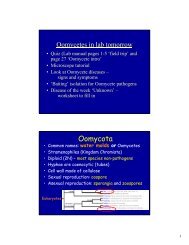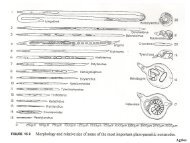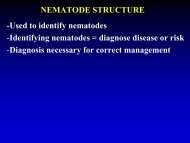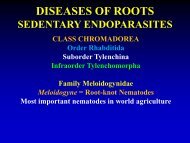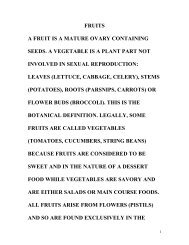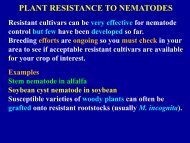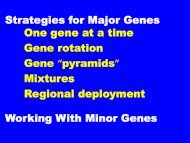Limitations to Chemical Control
Limitations to Chemical Control
Limitations to Chemical Control
You also want an ePaper? Increase the reach of your titles
YUMPU automatically turns print PDFs into web optimized ePapers that Google loves.
<strong>Limitations</strong> <strong>to</strong> <strong>Chemical</strong> <strong>Control</strong><br />
May not be effective based on environmental<br />
limitations = soil conditions, weather, etc.<br />
May not be economical.<br />
May not be any products registered for that crop.<br />
Product may be in short supply.
Cultural Strategies for Nema<strong>to</strong>de Management<br />
Nema<strong>to</strong>de Management With Plants<br />
- No plants – fallow<br />
- Nonhosts – crop rotation<br />
- Green manure cover crops<br />
- Timing of planting and harvest <strong>to</strong> avoid damage<br />
= “escaping in time”<br />
- Antagonistic plants<br />
- Trap crops<br />
- Resistant cultivars
Dry Fallow<br />
An extreme form of crop rotation where<br />
no crop is planted -> starve the nema<strong>to</strong>des<br />
Works best in areas with high soil temperatures and<br />
low rainfall or highly seasonal rainfall so that six<br />
months or more of hot, dry weather exist.<br />
Many nema<strong>to</strong>des are dead after six months of dry<br />
fallow and most are dead after one year.<br />
Others, such as cyst nema<strong>to</strong>des, remain viable for<br />
5-10+ years under fallow, but these are extreme cases.
<strong>Limitations</strong> <strong>to</strong> Dry Fallow<br />
1. Can you afford <strong>to</strong> take land out of production for a<br />
long enough period that fallow will be effective?<br />
= reduction in revenue<br />
2. Requires periodic disking, or harrowing <strong>to</strong> remove<br />
weeds or volunteer plants and <strong>to</strong> bring viable<br />
nema<strong>to</strong>des from below the surface <strong>to</strong> the harsher<br />
conditions at the surface. = operational cost<br />
3. There is also the problem of potential soil loss due <strong>to</strong><br />
erosion while there is no plant cover on the field.<br />
= environmental cost<br />
The bot<strong>to</strong>m line is that fallowing is not cost free!
Cultural Strategies for Nema<strong>to</strong>de Management<br />
Nema<strong>to</strong>de Management With Plants<br />
- No plants – fallow<br />
- Nonhosts – crop rotation<br />
- Green manure cover crops<br />
- Timing of planting and harvest <strong>to</strong> avoid damage<br />
= “escaping in time”<br />
- Antagonistic plants<br />
- Trap crops<br />
- Resistant cultivars
Crop Rotation<br />
Most common method of nema<strong>to</strong>de control.<br />
Plant crops that nema<strong>to</strong>des cannot feed/reproduce on.<br />
Population density is reduced by starvation.<br />
Host range for the target nema<strong>to</strong>de must be known.<br />
Rotation sequence selected depends on what<br />
nema<strong>to</strong>des need <strong>to</strong> be controlled and what crops can<br />
be grown and marketed in the area.<br />
Alternating graminoids such as corn (maize) or wheat<br />
with nongraminoids, like pota<strong>to</strong> or soybean effective.
<strong>Limitations</strong> of Crop Rotation<br />
The first limitation is that it only works for nema<strong>to</strong>des<br />
with a narrow host range like:<br />
- stem nema<strong>to</strong>des<br />
- cyst nema<strong>to</strong>des<br />
- and some root-knot nema<strong>to</strong>des<br />
but is less effective for nema<strong>to</strong>des with wide host ranges<br />
like:<br />
- root-lesion nema<strong>to</strong>des and<br />
- most migra<strong>to</strong>ry ec<strong>to</strong>parasites including virus<br />
vec<strong>to</strong>rs although this<br />
- can work for virus diseases if the crop is host<br />
for the nema<strong>to</strong>de vec<strong>to</strong>r but not for the virus.<br />
(TRV and alfalfa example.)
<strong>Limitations</strong> of Crop Rotation<br />
Second, often a limited number of cash crops in any<br />
given area that can be grown in a rotation sequence<br />
effectively.<br />
Often the most valuable crop is the most damaged.<br />
Grower must grow less profitable crop <strong>to</strong> suppress<br />
nema<strong>to</strong>des <strong>to</strong> nondamaging levels.<br />
For example, it may be necessary <strong>to</strong> grow wheat in<br />
order <strong>to</strong> suppress populations of northern root-knot<br />
nema<strong>to</strong>de Meloidogyne hapla which damage more<br />
valuable crops like pota<strong>to</strong>, carrot, or sugarbeet.
<strong>Limitations</strong> of Crop Rotation<br />
Growers and their bankers may be reluctant <strong>to</strong><br />
rotate from a high cash value crop <strong>to</strong> one of lesser<br />
value just <strong>to</strong> control nema<strong>to</strong>des.<br />
Often, it is still more economical <strong>to</strong> use nematicides<br />
and continue <strong>to</strong> grow the high value crop.<br />
In subsistence agriculture systems, farmers may have<br />
<strong>to</strong> grow crops that feed their family whether they are<br />
hosts for nema<strong>to</strong>des or not. May have little chance <strong>to</strong><br />
rotate.
<strong>Limitations</strong> of Crop Rotation<br />
Third limitation is that some nema<strong>to</strong>des, like cyst<br />
nema<strong>to</strong>des, can exist in soil as eggs for several years<br />
without a suitable host (= nema<strong>to</strong>de persistence).<br />
Grower may have <strong>to</strong> rotate away from a high cash<br />
value crop, like sugarbeet, for five or more years<br />
before nema<strong>to</strong>des decline <strong>to</strong> a nondamaging level.<br />
Often, it is still more practical <strong>to</strong> use nematicides and<br />
continue <strong>to</strong> grow the high value crop.
<strong>Limitations</strong> of Crop Rotation<br />
Fourth problem with crop rotation can occur if two or<br />
more nema<strong>to</strong>de pathogens are present in the same<br />
soil, each with different “alternative” hosts.<br />
An example of this problem exists in the Pacific<br />
Northwest where both M. hapla and M. chitwoodi may<br />
exist <strong>to</strong>gether. Both nema<strong>to</strong>des damage pota<strong>to</strong> but<br />
each has a different range of alternative hosts as well<br />
as nonhosts.
<strong>Limitations</strong> of Crop Rotation<br />
Growing wheat reduces M. hapla, which cannot<br />
reproduce on wheat, but maintains or increases<br />
M. chitwoodi, which reproduces well on wheat.<br />
Growing alfalfa reduces M. chitwoodi race 1 but<br />
maintains or increases M. hapla.<br />
This situation is further complicated since rotations<br />
with alfalfa <strong>to</strong> control M. chitwoodi appear <strong>to</strong> have<br />
selected for a second race of this nema<strong>to</strong>de that is<br />
capable of reproducing on alfalfa.
<strong>Limitations</strong> of Crop Rotation<br />
Volunteer plants from the previous host crop and<br />
weeds must be strictly controlled during the rotation.<br />
Although it is often overlooked, weeds can be good<br />
hosts for nema<strong>to</strong>des that damage crops.<br />
Of course, rotation is only practical for annual crops<br />
or short-term perennials like alfalfa or strawberry<br />
and is of no value <strong>to</strong> long-lived perennials.<br />
So, there can be several considerations <strong>to</strong> address<br />
before implementing crop rotation for<br />
nema<strong>to</strong>de management but it can still be effective.
Crop Rotation<br />
Nema<strong>to</strong>de Management With Crop Rotation<br />
May Be Enhanced with Green Manure Crops
Cultural Strategies for Nema<strong>to</strong>de Management<br />
Nema<strong>to</strong>de Management With Plants<br />
- No plants – fallow<br />
- Nonhosts – crop rotation<br />
- Green manure cover crops<br />
- Timing of planting and harvest <strong>to</strong> avoid damage<br />
= “escaping in time”<br />
- Antagonistic plants<br />
- Trap crops<br />
- Resistant cultivars
Cultural Strategies for Nema<strong>to</strong>de Management<br />
See Green Manure Cover Crop File



